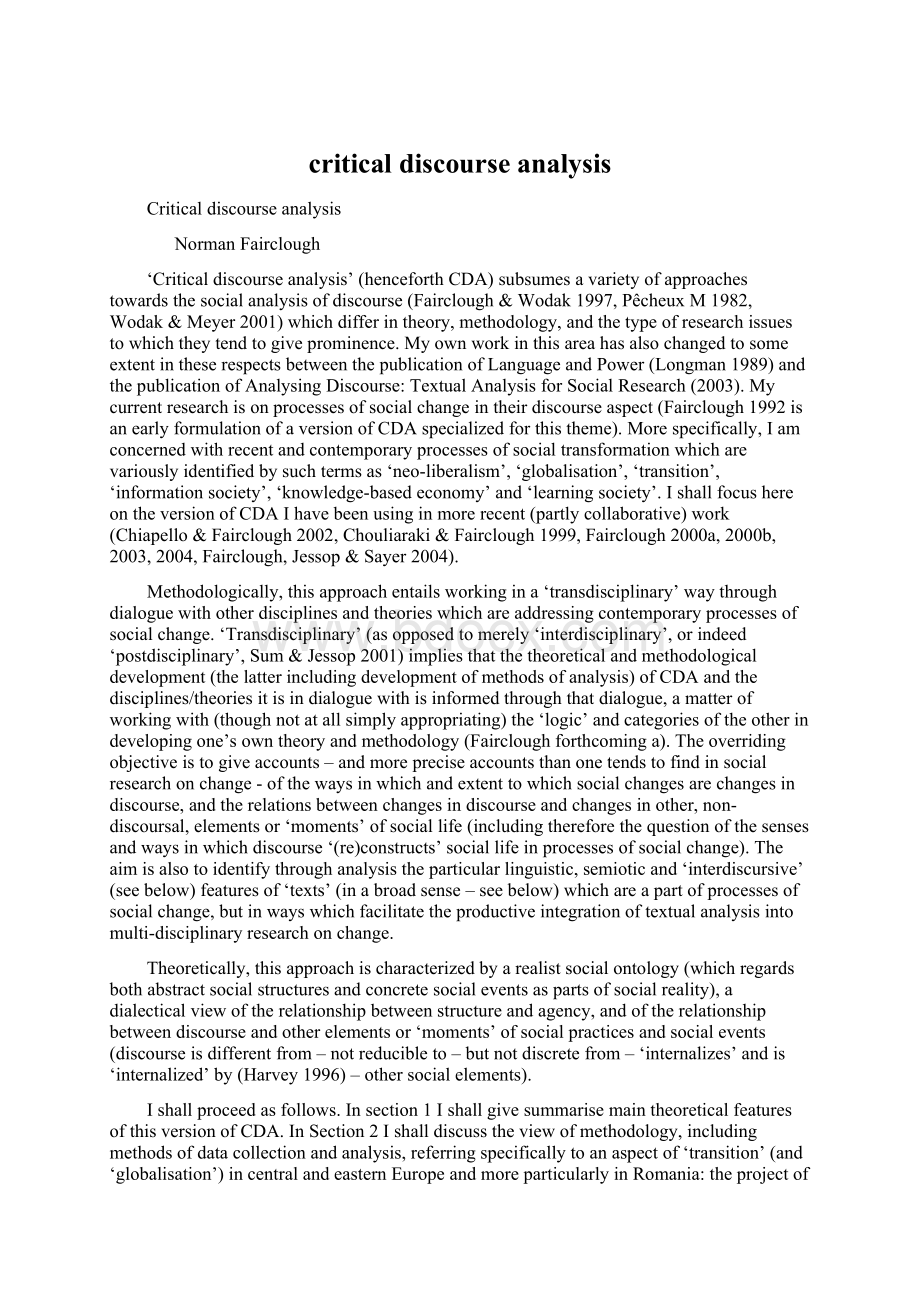critical discourse analysis.docx
《critical discourse analysis.docx》由会员分享,可在线阅读,更多相关《critical discourse analysis.docx(18页珍藏版)》请在冰豆网上搜索。

criticaldiscourseanalysis
Criticaldiscourseanalysis
NormanFairclough
‘Criticaldiscourseanalysis’(henceforthCDA)subsumesavarietyofapproachestowardsthesocialanalysisofdiscourse(Fairclough&Wodak1997,PêcheuxM1982,Wodak&Meyer2001)whichdifferintheory,methodology,andthetypeofresearchissuestowhichtheytendtogiveprominence.MyownworkinthisareahasalsochangedtosomeextentintheserespectsbetweenthepublicationofLanguageandPower(Longman1989)andthepublicationofAnalysingDiscourse:
TextualAnalysisforSocialResearch(2003).Mycurrentresearchisonprocessesofsocialchangeintheirdiscourseaspect(Fairclough1992isanearlyformulationofaversionofCDAspecializedforthistheme).Morespecifically,Iamconcernedwithrecentandcontemporaryprocessesofsocialtransformationwhicharevariouslyidentifiedbysuchtermsas‘neo-liberalism’,‘globalisation’,‘transition’,‘informationsociety’,‘knowledge-basedeconomy’and‘learningsociety’.IshallfocushereontheversionofCDAIhavebeenusinginmorerecent(partlycollaborative)work(Chiapello&Fairclough2002,Chouliaraki&Fairclough1999,Fairclough2000a,2000b,2003,2004,Fairclough,Jessop&Sayer2004).
Methodologically,thisapproachentailsworkingina‘transdisciplinary’waythroughdialoguewithotherdisciplinesandtheorieswhichareaddressingcontemporaryprocessesofsocialchange.‘Transdisciplinary’(asopposedtomerely‘interdisciplinary’,orindeed‘postdisciplinary’,Sum&Jessop2001)impliesthatthetheoreticalandmethodologicaldevelopment(thelatterincludingdevelopmentofmethodsofanalysis)ofCDAandthedisciplines/theoriesitisindialoguewithisinformedthroughthatdialogue,amatterofworkingwith(thoughnotatallsimplyappropriating)the‘logic’andcategoriesoftheotherindevelopingone’sowntheoryandmethodology(Faircloughforthcominga).Theoverridingobjectiveistogiveaccounts–andmorepreciseaccountsthanonetendstofindinsocialresearchonchange-ofthewaysinwhichandextenttowhichsocialchangesarechangesindiscourse,andtherelationsbetweenchangesindiscourseandchangesinother,non-discoursal,elementsor‘moments’ofsociallife(includingthereforethequestionofthesensesandwaysinwhichdiscourse‘(re)constructs’sociallifeinprocessesofsocialchange).Theaimisalsotoidentifythroughanalysistheparticularlinguistic,semioticand‘interdiscursive’(seebelow)featuresof‘texts’(inabroadsense–seebelow)whichareapartofprocessesofsocialchange,butinwayswhichfacilitatetheproductiveintegrationoftextualanalysisintomulti-disciplinaryresearchonchange.
Theoretically,thisapproachischaracterizedbyarealistsocialontology(whichregardsbothabstractsocialstructuresandconcretesocialeventsaspartsofsocialreality),adialecticalviewoftherelationshipbetweenstructureandagency,andoftherelationshipbetweendiscourseandotherelementsor‘moments’ofsocialpracticesandsocialevents(discourseisdifferentfrom–notreducibleto–butnotdiscretefrom–‘internalizes’andis‘internalized’by(Harvey1996)–othersocialelements).
Ishallproceedasfollows.Insection1IshallgivesummarisemaintheoreticalfeaturesofthisversionofCDA.InSection2Ishalldiscusstheviewofmethodology,includingmethodsofdatacollectionandanalysis,referringspecificallytoanaspectof‘transition’(and‘globalisation’)incentralandeasternEuropeandmoreparticularlyinRomania:
theprojectofdeveloping‘informationsocieties’and‘knowledge-basedeconomies’.IshalldevelopthisexampleinSection3,discussingtherecontextualizationofdiscoursesofthe‘informationsociety’and‘knowledge-basedeconomy’inaRomanianpolicydocument.
1.Theoreticalissues
Theterm‘discourse’isusedinvariouswayswithinthebroadfieldofdiscourseanalysis.Twoareofparticularrelevancehere.First,‘discourse’inanabstractsenseasacategorywhichdesignatesthebroadlysemioticelements(asopposedtoandinrelationtoother,non-semiotic,elements)ofsociallife(language,butalsovisualsemiosis,‘bodylanguage’etc).Iprefertousetheterm‘semiosis’(Fairclough,Jessop&Sayer2004)toavoidthecommonconfusionofthissenseof‘discourse’withthesecond,whichIretain:
‘discourse’asacountnoun,asacategoryfordesignatingparticularwaysofrepresentingparticularaspectsofsociallife(egitiscommontodistinguishdifferentpoliticaldiscourses,whichrepresentforexampleproblemsofinequality,disadvantage,poverty,‘socialexclusion’,indifferentways).Thecategoryof‘discourse’inthissecondsenseisdefinedthroughitsrelationtoanddifferencefromtwoothercategories,‘genre’and‘style’(seebelow).
Therealistsocialontologyadoptedheretreatssocialstructuresaswellassocialeventsaspartsofsocialreality.Likeanumbersocialtheorists,suchasBourdieuandBhaskar(Bourdieu&Wacquant1992,Bhaskar1986),Iassumethatcoherentaccountsoftherelationshipbetweensocialstructuresandsocialeventsdependuponmediatingcategories,forwhichIshallusetheterm‘socialpractices’,meaningmoreorlessstableanddurableformsofsocialactivity,whicharearticulatedtogethertoconstitutesocialfields,institutions,andorganizations.Thereisasemioticdimensionateachoftheselevels.Languages(aswellasothersemioticsystems)areaparticulartypeofsocialstructure.Iusetheterm‘orderofdiscourse’(thetermisFoucault’s,butitisrecontextualizedwithinthisversionofCDAinadistinctiveway,seeFoucault1984,Fairclough1992,2003)forthesemioticdimensionofarticulatednetworksofsocialpractices(forinstance,thepoliticalfieldispartlyconstitutedasaparticularorderofdiscourse,sotooarespecificgovernmental,educationalorbusinessorganizations).Iusetheterm‘text’inanextendedwayforthesemioticdimensionofsocialevents–thewrittendocumentsandwebsitesofgovernmentare‘texts’inthissense,asalsoareinterviewsandmeetingsingovernmentorbusinessorganisations(Fairclough2003).Theterm‘text’isnotreallyfelicitoususedinthisway,becauseonecannotshakeoffitsprimaryassociationwithwrittentexts,butitisdifficulttofindapreferablegeneralterm.
Socialpracticesand,ataconcretelevel,socialevents,arearticulationsofdiversesocialelements,includingsemiosis.Onemightforinstanceseesocialpracticesasincludingthefollowingelements(thoughthereisclearlyroomforargumentaboutwhattheelementsare):
Activities
Socialrelations
Objectsandinstruments
Timeandplace
Socialsubjects,withbeliefs,knowledge,valuesetc
Semiosis
Theseelementsaredialecticallyrelated(Harvey1996).Thatistosay,theyaredifferentelements,butnotdiscrete,fullyseparate,elements.Thereisasenseinwhicheach‘internalizes’theotherswithoutbeingreducibletothem.Soforinstancesocialrelationsinorganizationsclearlyhaveapartlysemioticcharacter,butthatdoesnotmeanthatwesimplytheorizeandresearchsocialrelationsinthesamewaythatwetheorizeandresearchlanguage.Theyhavedistinctproperties,andresearchingthemgivesrisetodistinctdisciplines.Conversely,textsaresomassively‘overdetermined’(Althusser&Balibar1970,Fairclough,Jessop&Sayer2004)byothersocialelementsthatlinguisticanalysisoftextsquicklyfindsitselfaddressingquestionsaboutsocialrelations,socialidentities,institutions,andsoforth,butthisdoesnotmeanthatlinguisticanalysisoftextsisreducibletoformsofsocialanalysis.Nevertheless,thedialecticalcharacterofrelationsbetweenelementsunderscoresthevalueandimportanceofworkingacrossdisciplinesina‘transdisciplinary’way.
Semiosisfiguresinbroadlythreewaysinsocialpractices(andthearticulationsofpracticeswhichconstitutesocialfields,institutions,organizations)andsocialevents.First,itfiguresasapartofthesocialactivity,partoftheaction(andinteraction).Forinstance,partofdoingajob(forinstance,beingashopassistant)isusinglanguageinaparticularway;sotooispartofgoverningacountry.Second,semiosisfiguresinrepresentations.Socialactorsactingwithinanyfieldororganizationproducerepresentationsofotherpractices,aswellas(‘reflexive’)representationsoftheirownpractices,inthecourseoftheiractivity,anddifferentsocialactorswillrepresentthemdifferentlyaccordingtohowtheyarepositionedwithinfieldsororganizations.Third,semiosisfiguresinwaysofbeing,intheconstitutionofidentities–forinstancetheidentityofapoliticalleadersuchasTonyBlairintheUKispartlyasemioticallyconstitutedwayofbeing(Fairclough2000b).
Semiosisaspartofsocialactivityconstitutes‘genres’.Genresarediversewaysof(inter)actingintheirspecificallysemioticaspect.Examplesare:
meetingsinvarioustypesoforganisation,politicalandotherformsofinterview,newsarticlesinthepress,andbookreviews.Semiosisintherepresentationandself-representationofsocialpracticesconstitutes‘discourses’.Discoursesarediverserepresentationsofsociallife.Forinstance,thelivesofpooranddisadvantagedpeoplearerepresentedthroughdifferentdiscoursesinthesocialpracticesofgovernment,politics,medicine,andsocialscience,aswellasthroughdifferentdiscourseswithineachofthesepracticescorrespondingtodifferentpositionsofsocialactors.Finally,semiosisaspartofwaysofbeingconstitutes‘styles’–forinstancethestylesofbusinessmanagers,orpoliticalleaders.
Thesemioticaspectofasocialfieldorinstitutionororganization(ieofaspecificartic